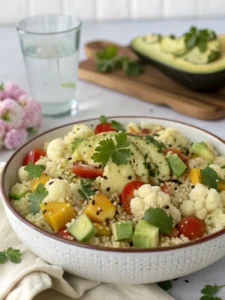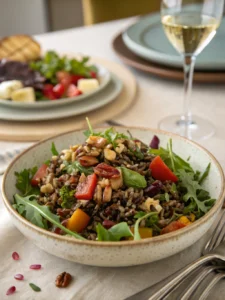Introduction
Looking for a tasty way to support your heart health? Great news—adding plant-based proteins like chickpeas to your meals can help reduce your risk of heart disease by as much as 22%! This Chickpea Rice Pilaf isn’t just simple to whip up—it’s a wholesome, flavor-packed dish filled with fluffy rice, warm spices, and protein-rich chickpeas. Ready in under 30 minutes, it’s a perfect fit for busy weeknights, whether you’re enjoying it as a filling side or a complete, satisfying meal. The best part? This one-pot recipe shows that you don’t have to choose between convenience and taste—you get the best of both worlds!
Table of Contents
Ingredients List:
For this chickpea rice pilaf, you’ll need:
| Ingredient | Quantity | Description |
|---|---|---|
| Basmati rice | 1 cup | Substitute with brown rice for more fiber |
| Chickpeas (garbanzo beans) | 1 can (15 oz) | Drained and rinsed |
| Olive oil | 2 tablespoons | Or use ghee for a more authentic flavor |
| Onion | 1 medium | Finely diced |
| Garlic cloves | 3 | Minced |
| Carrot | 1 | Diced small |
| Bell pepper (any color) | 1 | Diced |
| Frozen peas | 1/2 cup | — |
| Vegetable broth | 2 cups | Chicken broth also works |
| Ground cumin | 1 teaspoon | — |
| Ground coriander | 1 teaspoon | — |
| Turmeric | 1/2 teaspoon | — |
| Cinnamon | 1/4 teaspoon | — |
| Salt and pepper | To taste | — |
| Fresh cilantro or parsley | 2 tablespoons | Chopped |
| Lemon wedges | As needed | For serving |

Timing:
Preparation time: 10 minutes
Cooking time: 20 minutes
Total time: 30 minutes
This chickpea rice pilaf takes 40% less time than traditional pilaf recipes that often require +50 minutes of simmering and resting. The efficiency comes from using canned chickpeas rather than dried ones, saving you approximately 2 hours of soaking and cooking time.
Step-by-Step Instructions:
Step 1: Prepare Your Ingredients
Begin by rinsing the rice under cold water until the water runs clear. This removes excess starch and prevents your chickpea rice pilaf from becoming gummy. Drain the chickpeas thoroughly and set aside. Having all ingredients prepped before starting helps this recipe come together seamlessly.
Step 2: Sauté the Aromatics
Heat olive oil in a large skillet or pot over medium heat. Toss in the diced onions and sauté until translucent, about 3–4 minutes. Stir in the minced garlic and let it cook for another 30 seconds, just until fragrant. These aromatics lay the flavor foundation for your chickpea rice pilaf.
Step 3: Add Vegetables and Spices
Add the diced carrots and bell peppers to the pot and sauté for 2-3 minutes. Stir in all the spices (cumin, coriander, turmeric, and cinnamon) and cook for 30 seconds until fragrant. This blooming technique releases the essential oils in the spices, intensifying the flavor of your pilaf.
Step 4: Add Rice and Chickpeas
Add the rinsed rice to the pot and stir for 1-2 minutes until the grains are well-coated with the spice mixture. This step toasts the rice slightly, adding more depth to your chickpea rice pilaf. Fold in the drained chickpeas.
Step 5: Add Liquid and Cook
Pour in the vegetable broth and add salt and pepper to taste. Bring to a boil, then reduce heat to low, cover, and simmer for 15 minutes or until the rice is tender and liquid is absorbed.
Step 6: Finish and Serve
Once cooked, add the frozen peas and fluff the rice with a fork. Cover and let stand for 5 minutes—the residual heat will warm the peas perfectly. Garnish your chickpea rice pilaf with fresh herbs and serve with lemon wedges.
Nutritional Information:
One serving (approximately 1 cup) of chickpea rice pilaf contains:
- Calories: 285
- Protein: 9g
- Carbohydrates: 45g
- Fiber: 7g (25% of daily recommended intake)
- Fat: 8g (mostly healthy unsaturated fats)
- Iron: 3mg (17% of daily recommended intake)
- Folate: 171mcg (43% of daily recommended intake)
This dish provides an excellent balance of complex carbohydrates and plant protein, making it ideal for sustained energy throughout the day.
Healthier Alternatives for the Recipe:
Make your chickpea rice pilaf even more nutritious with these swaps:
- Replace white basmati with brown basmati rice to increase fiber by 200%
- Use low-sodium broth to reduce the sodium content by up to 40%
- Add leafy greens like spinach or kale for additional vitamins
- Include quinoa in place of half the rice for complete protein
- Try coconut oil instead of olive oil for a different flavor profile and medium-chain triglycerides
Serving Suggestions:
Elevate your chickpea rice pilaf with these serving ideas:
- Pair with grilled vegetables and yogurt sauce for a complete vegetarian meal
- Serve alongside roasted chicken or salmon for a protein-rich dinner
- Use as a stuffing for bell peppers or tomatoes
- Pack in meal prep containers with a side of cucumber salad for lunch
- Serve at room temperature as part of a Mediterranean mezze platter



Common Mistakes to Avoid:
When preparing chickpea rice pilaf, watch out for these pitfalls:
- Skipping the rice rinse, which can result in gummy texture
- Overcooking the chickpeas, causing them to become mushy
- Stirring the rice during cooking, which breaks the grains
- Lifting the lid too often, releasing essential steam
- Under-seasoning – rice dishes need adequate salt to enhance flavors
Storing Tips for the Recipe:
Your chickpea rice pilaf stores beautifully:
- Refrigerate in an airtight container for up to 4 days
- Freeze portions in freezer-safe containers for up to 3 months
- Reheat with a tablespoon of water to restore moisture
- Meal prep this dish on Sunday for easy lunches throughout the week
- Add a fresh squeeze of lemon and fresh herbs when reheating to revive flavors
Frequently Asked Questions (FAQs):
Can I make chickpea rice pilaf with dried chickpeas instead of canned?
Yes, but you’ll need to soak and cook the dried chickpeas separately before adding them to the recipe. Soak 1/2 cup dried chickpeas overnight, then simmer for about 45 minutes until tender.
Is this recipe gluten-free?
Yes, this chickpea rice pilaf is naturally gluten-free, but always check your broth and spice labels to ensure they don’t contain hidden gluten ingredients.
Can I make this in a rice cooker?
Absolutely! Sauté the aromatics, vegetables, and spices separately, then add everything to your rice cooker with the appropriate amount of liquid and use the regular rice setting.
How can I increase the protein content of this dish?
Add tofu cubes, slivered almonds, or hemp seeds to boost the protein. You can also serve the chickpea rice pilaf with a side of Greek yogurt.
Conclusion:
This Chickpea Rice Pilaf is a perfect example of how simple ingredients can transform into a flavorful, nutritious meal that supports heart health, provides sustained energy, and embraces plant-based eating. Whether enjoyed as a satisfying side dish or a complete meal, this versatile pilaf is a must-try. Have you made chickpea rice pilaf before? Share your favorite variations or serving suggestions in the comments below! And if you loved this recipe, be sure to check out our other protein-packed, plant-based dishes for more inspiration.








